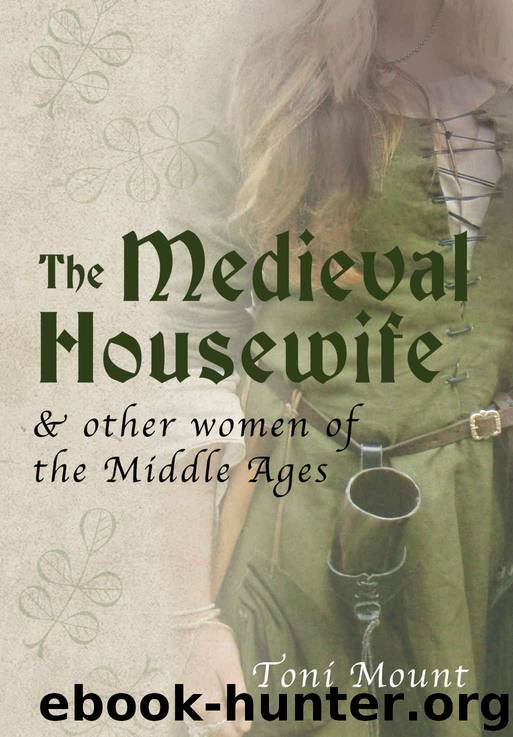The Medieval Housewife & Other Women of the Middle Ages by Mount Toni

Author:Mount, Toni [Mount, Toni]
Language: eng
Format: azw3
Publisher: Amberley Publishing
Published: 2015-03-24T16:00:00+00:00
Mrs Noah in Noah’s Ark. (MS Harley 4381 f. 12, British Library – Bible Historiale, France, 1403)
Japheth:
Mother, we pray you altogether –
For we are here your own childer –
Come into the ship for fear of the weather,
For his love that you bought [Your redeemer]!
Noah’s Wife:
That will I not, for all your call [bidding],
Whether you will or nought.
(They drag her up the gangplank.)
Noah:
Welcome, wife, into this boat.
Noah’s Wife:
And have thou that for thy note [trouble]!
(She boxes his ears)
EFFECTS OF THE BLACK DEATH
In 1348, the great pestilence, as it was called at the time (the Black Death being a later name given to the most terrible scourge known to mankind in the Middle Ages), arrived in England on the Dorset coast at Melcombe Regis. We are not going to discuss the plague itself, but rather the drastic effect it had on the lives of the peasants in the years following. However, we must first think about the situation in England before its catastrophic arrival.
Around the year 1300, the population of England was at its maximum, perhaps between 5 and 6 million – a peak it did not achieve again until Stuart times. This high population meant that areas of crop-growing had been extended to provide food for so many; parts of Dartmoor, for instance, were cultivated, as were other areas of poor soil. Known as marginal land, such areas were literally on the edge of cultivation and subsistence. Where the soil had previously been fertile and productive, it was now over-worked: fields were not allowed to lie fallow to recover and the failure to rotate crops, as had been done in the past, drained the goodness from the earth. Forests were cut down so more land could be cultivated, but demand always outstripped production and, eventually, the wholesale removal of woodland led to less ‘free’ food being available from the countryside and a shortage of fuel and building material.
With population levels at their highest throughout Europe, the climate then took a hand, plunging the whole area into a ‘mini ice age’. The intense cold led to a significant advance of the polar icecap and the alpine glaciers, and high rainfall was dramatic enough to cause a rise in the level of the Caspian Sea. The cultivation of cereal crops in Iceland was no longer possible, neither was the growing of vines in much of England. The wheat-growing areas of Scandinavia and the French upland regions were greatly reduced. The worst result of this climate change was a series of disastrous famines. Between 1315 and 1319, almost every country in Europe lost virtually the whole of one harvest, often two or three. The lack of sunshine hindered the ripening of grain and fruits, as well as the production of salt by evaporation, which was the most common and cheapest method of making it. Since salt was vital for preserving meat, this too was also quickly in short supply. In England, wheat more than doubled in price and peasants, so it was recorded, were reduced to eating cats and dogs, even children, according to one chronicler.
Download
This site does not store any files on its server. We only index and link to content provided by other sites. Please contact the content providers to delete copyright contents if any and email us, we'll remove relevant links or contents immediately.
| Civilization & Culture | Expeditions & Discoveries |
| Jewish | Maritime History & Piracy |
| Religious | Slavery & Emancipation |
| Women in History |
Cecilia; Or, Memoirs of an Heiress — Volume 1 by Fanny Burney(32078)
Cecilia; Or, Memoirs of an Heiress — Volume 3 by Fanny Burney(31470)
Cecilia; Or, Memoirs of an Heiress — Volume 2 by Fanny Burney(31420)
The Secret History by Donna Tartt(18223)
Sapiens: A Brief History of Humankind by Yuval Noah Harari(13999)
Leonardo da Vinci by Walter Isaacson(12815)
The Radium Girls by Kate Moore(11639)
Sapiens by Yuval Noah Harari(5128)
How Democracies Die by Steven Levitsky & Daniel Ziblatt(4970)
The Wind in My Hair by Masih Alinejad(4852)
Homo Deus: A Brief History of Tomorrow by Yuval Noah Harari(4694)
Endurance: Shackleton's Incredible Voyage by Alfred Lansing(4518)
Man's Search for Meaning by Viktor Frankl(4299)
The Silk Roads by Peter Frankopan(4275)
Millionaire: The Philanderer, Gambler, and Duelist Who Invented Modern Finance by Janet Gleeson(4115)
The Rape of Nanking by Iris Chang(4025)
Hitler in Los Angeles by Steven J. Ross(3803)
Joan of Arc by Mary Gordon(3796)
The Motorcycle Diaries by Ernesto Che Guevara(3795)
